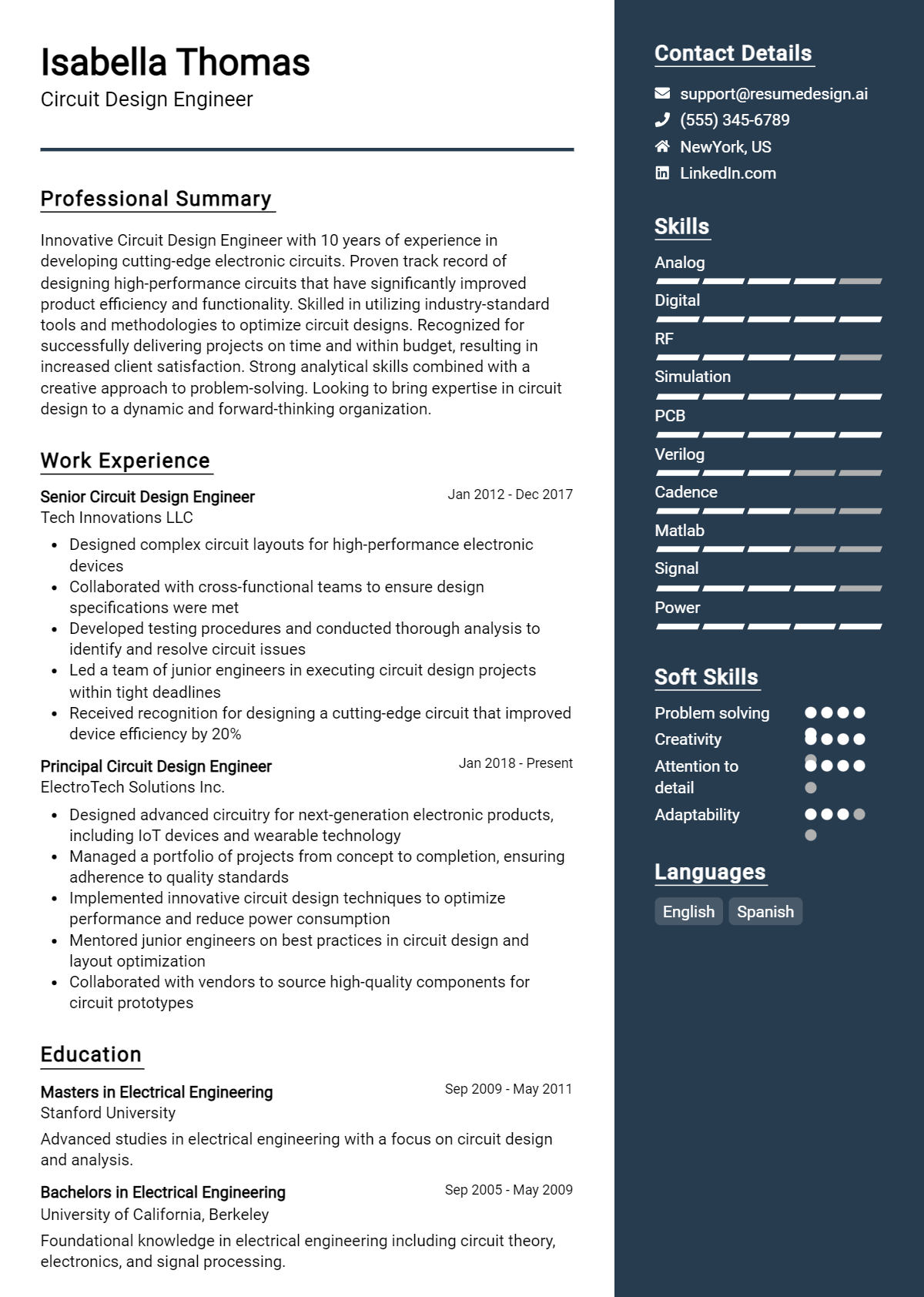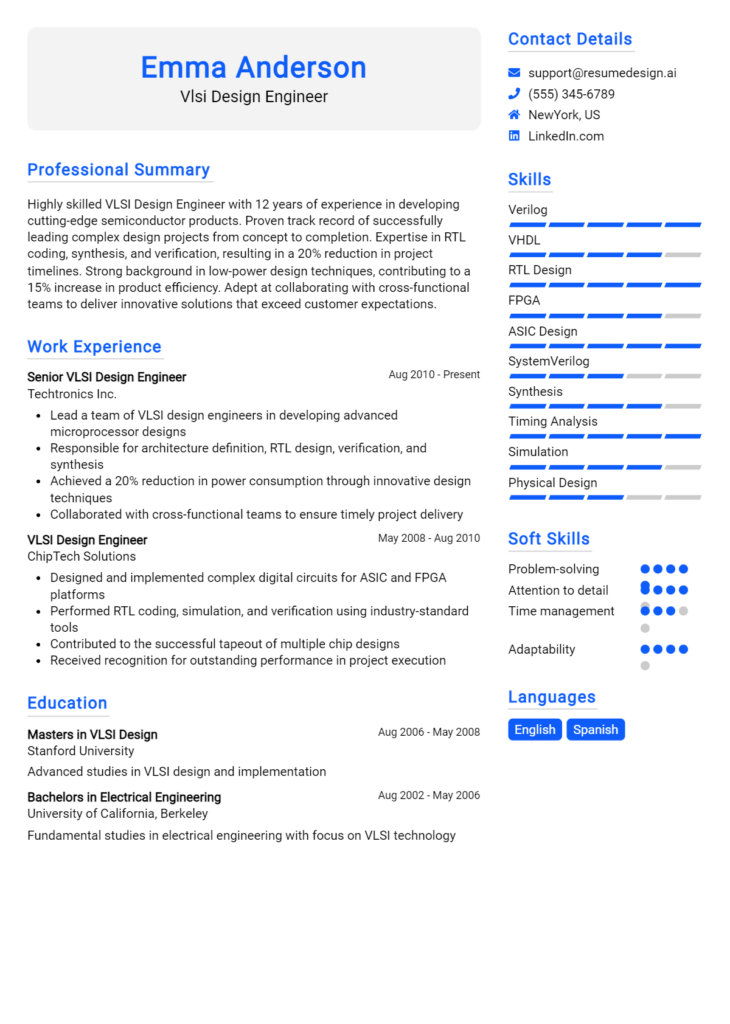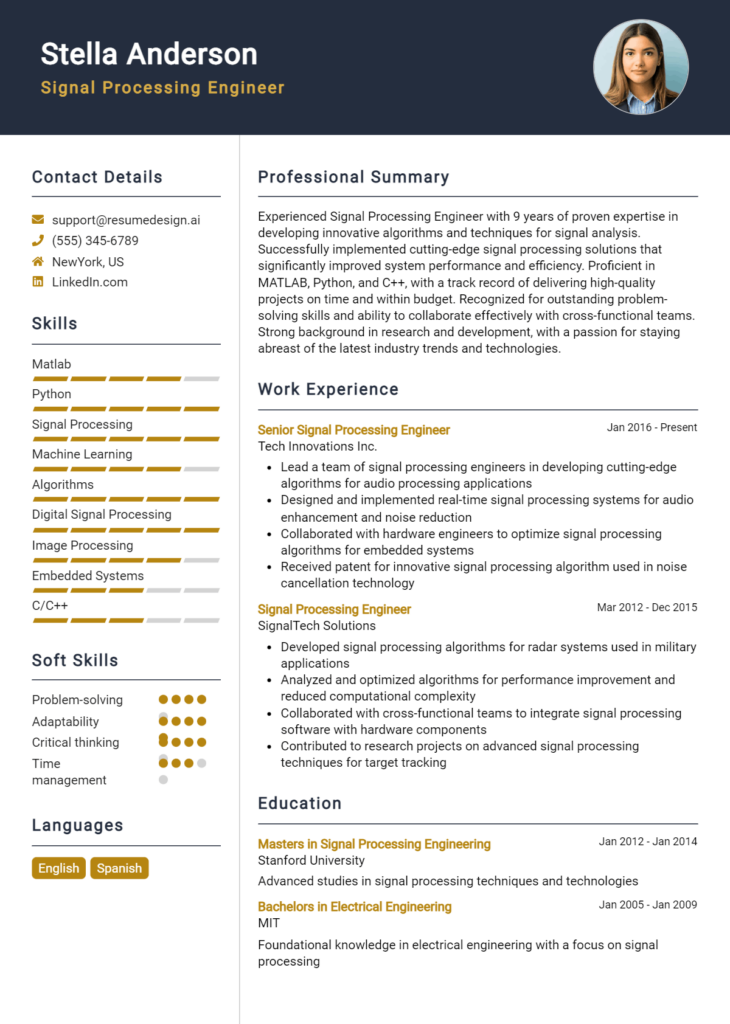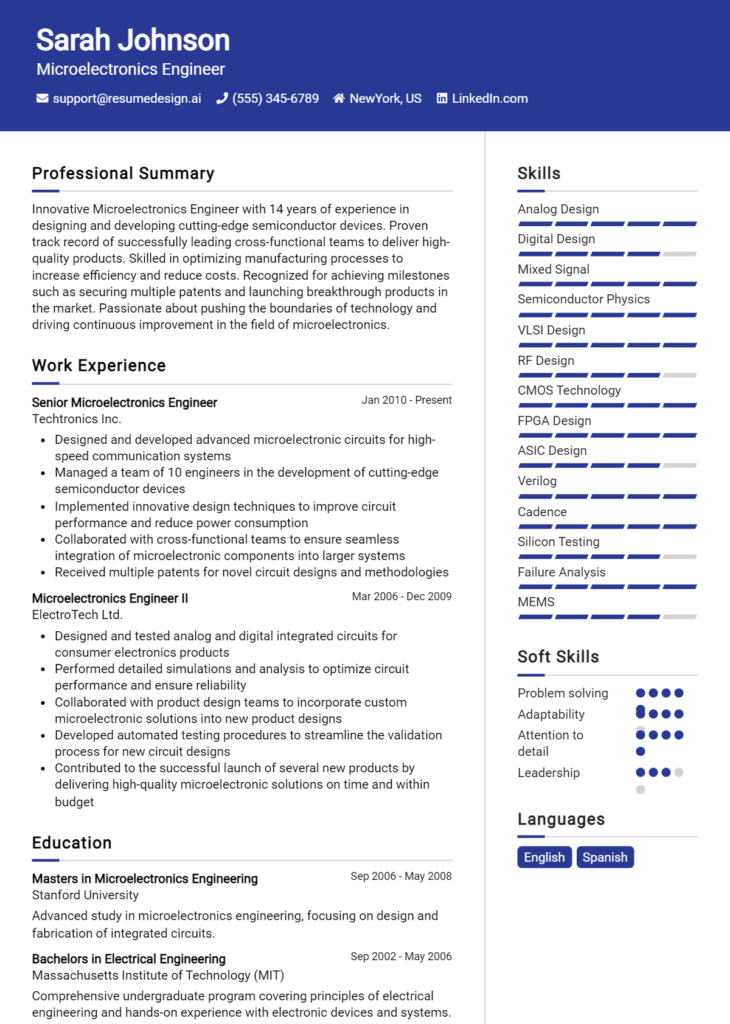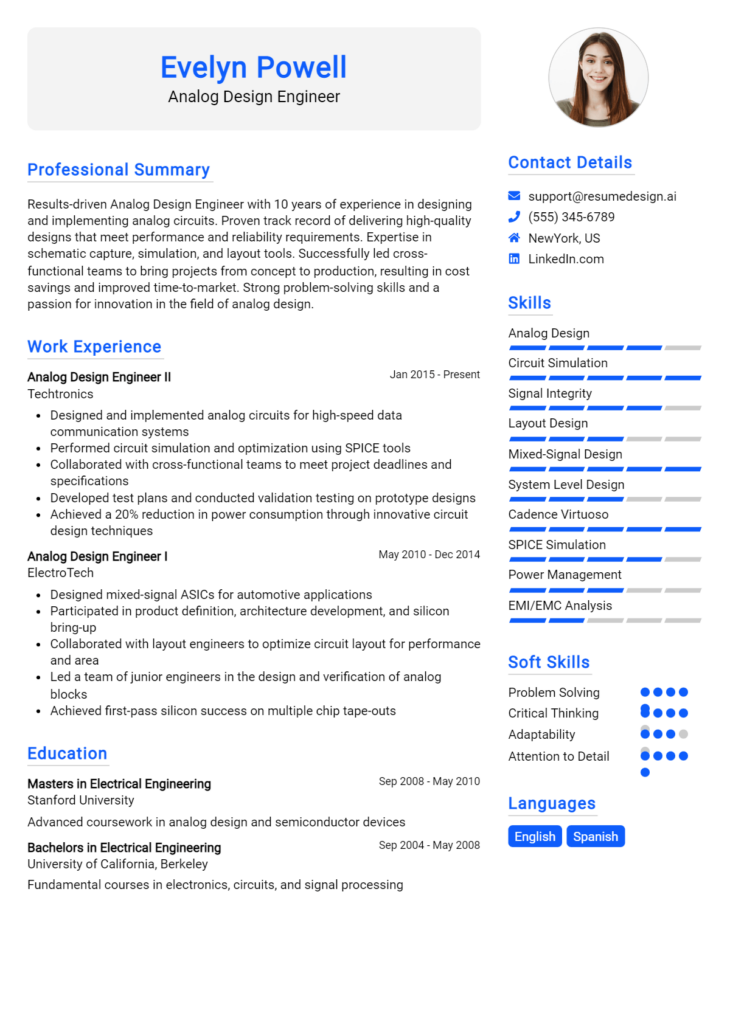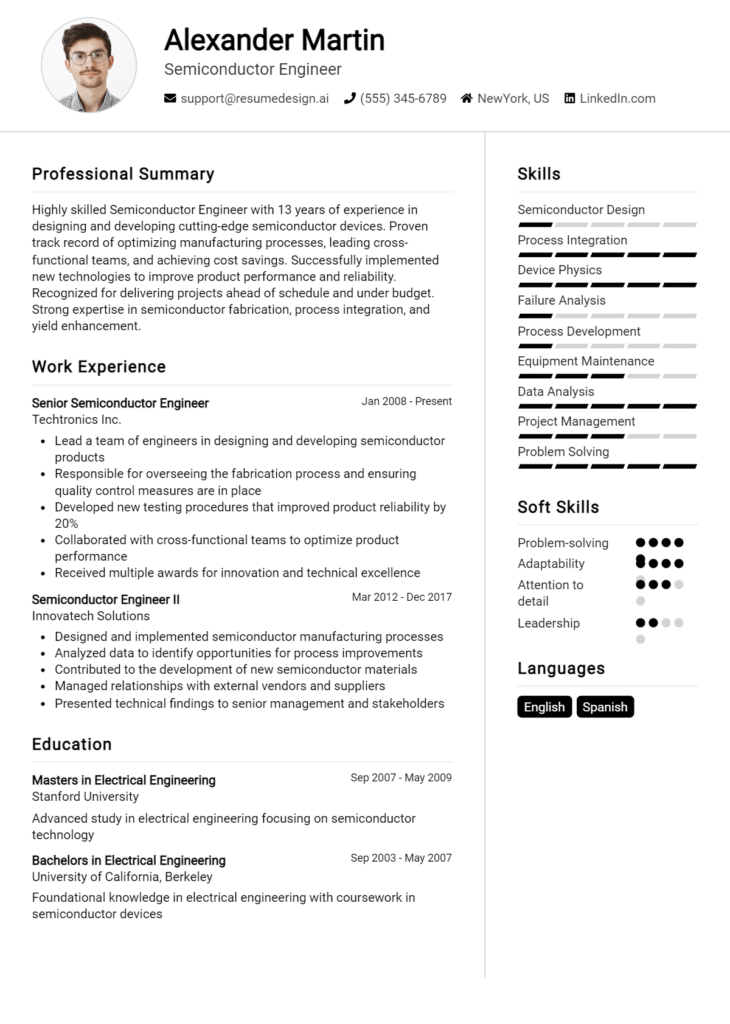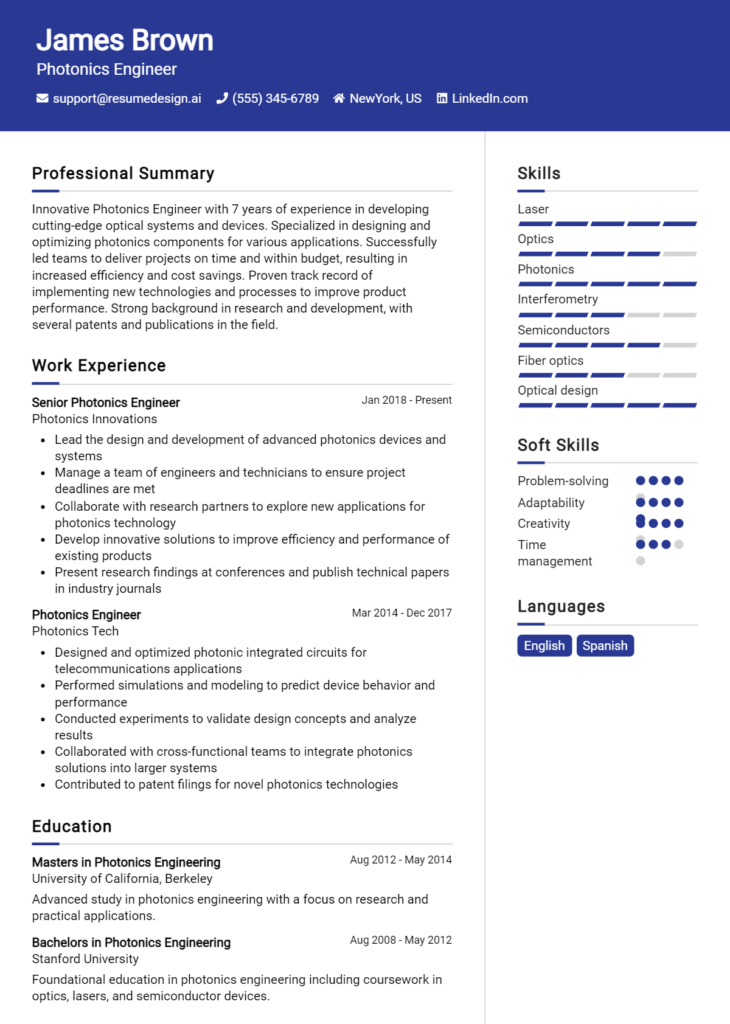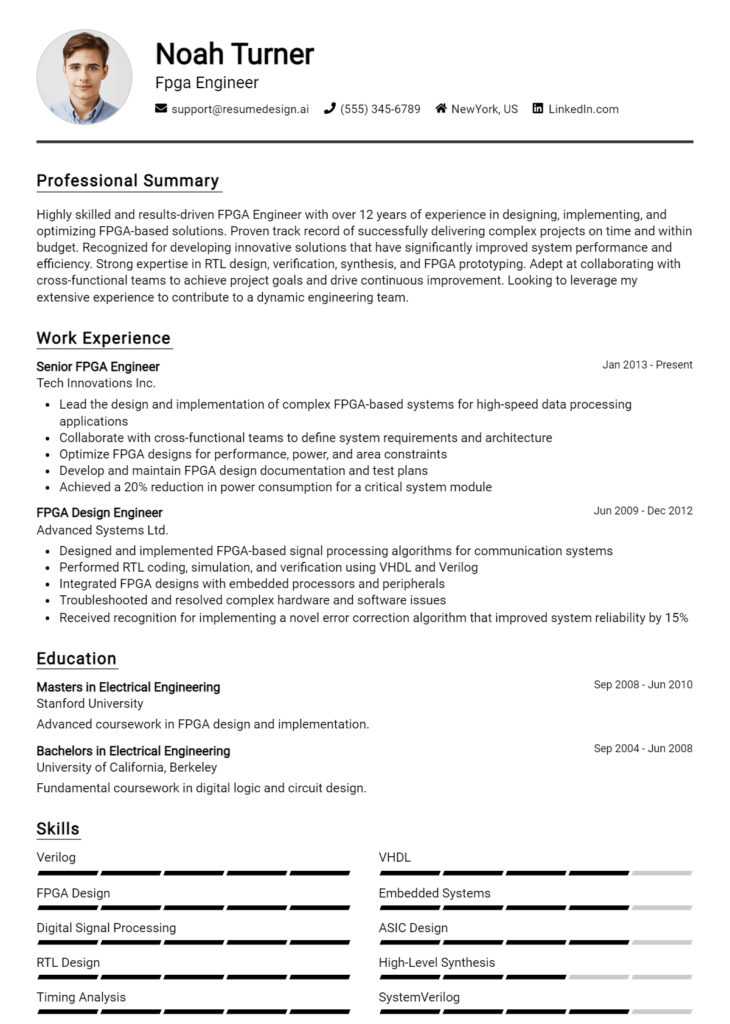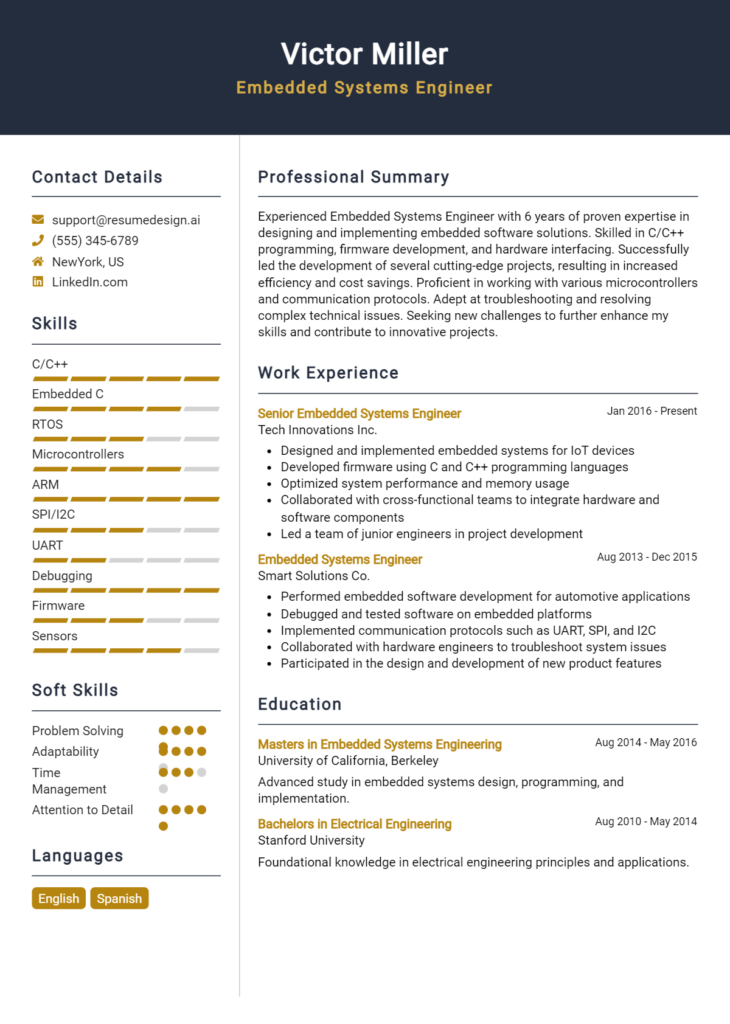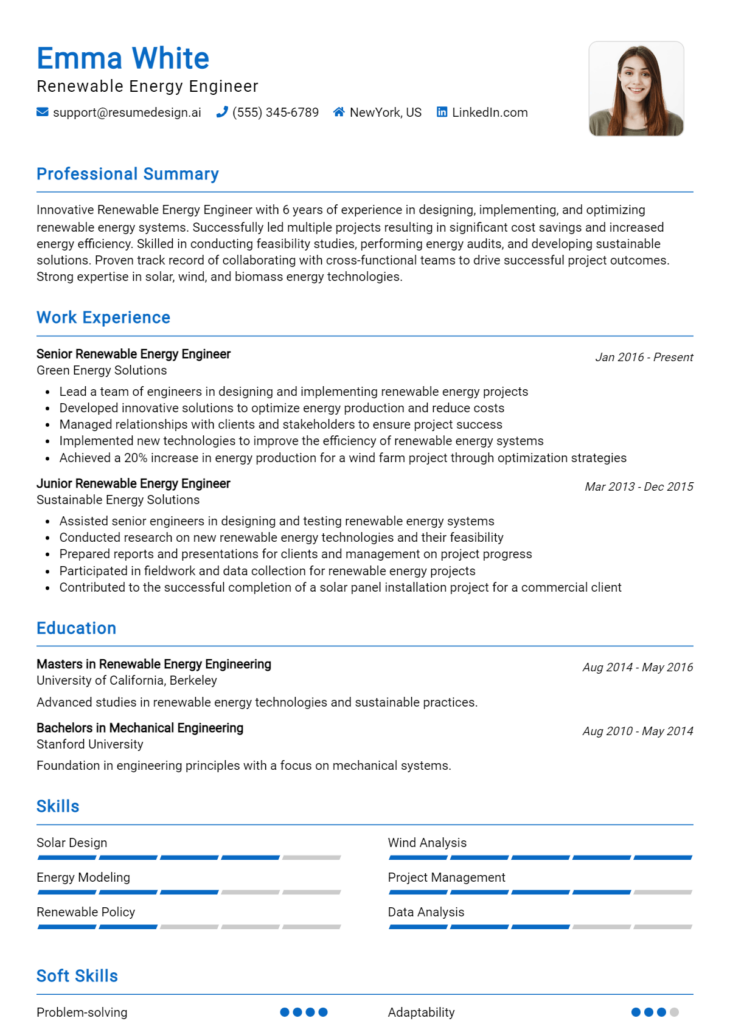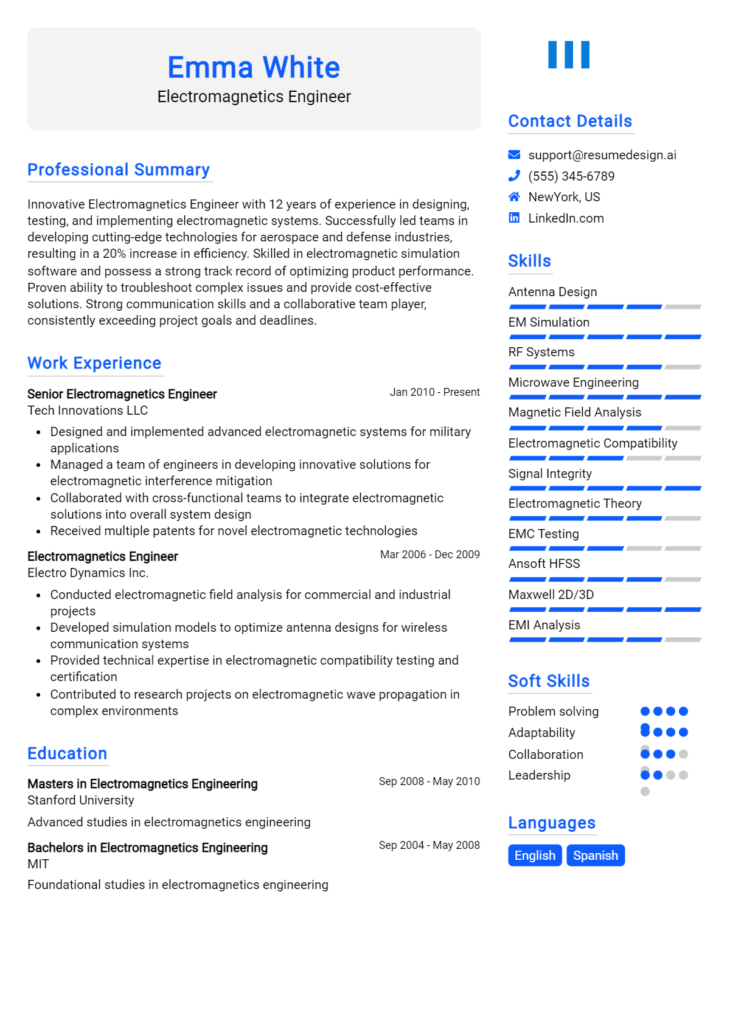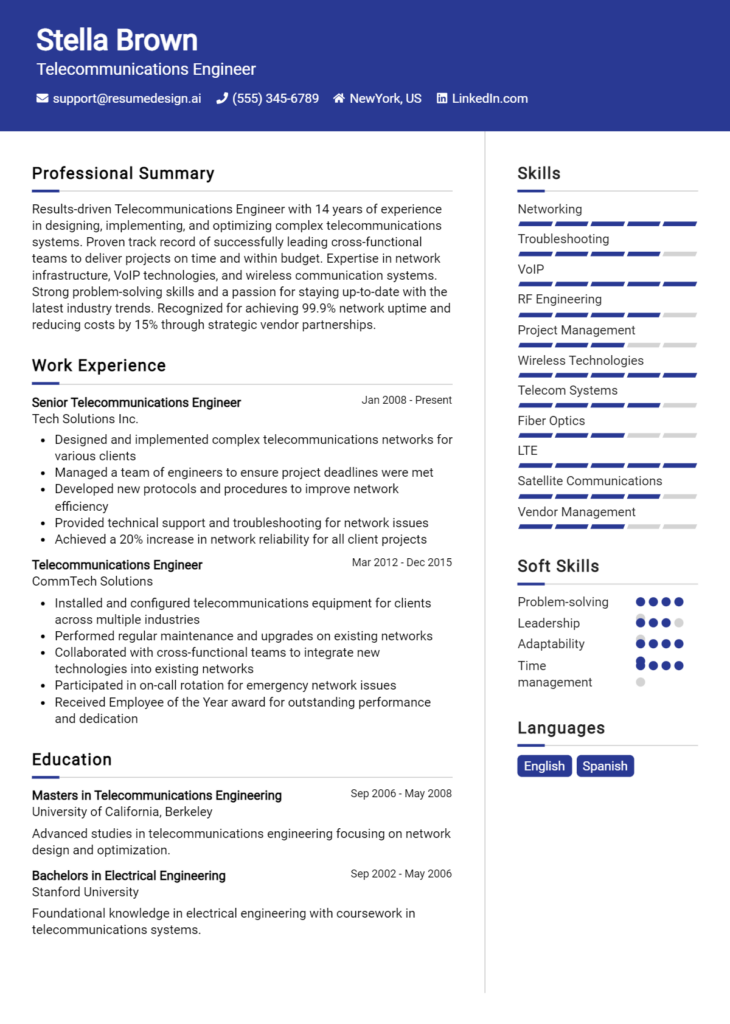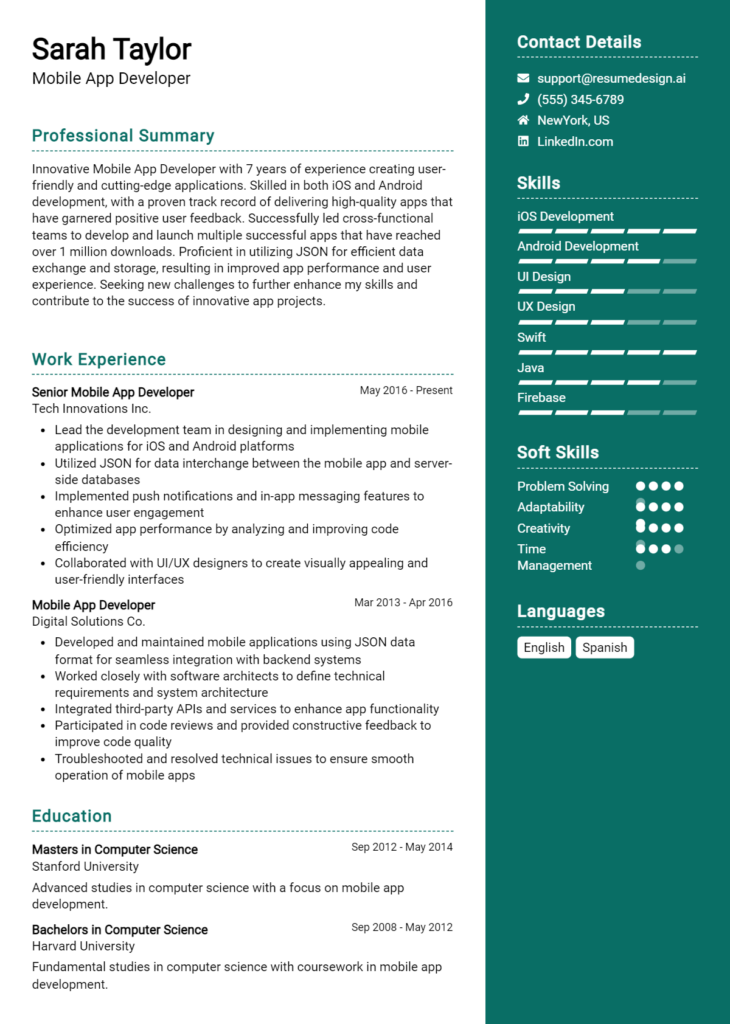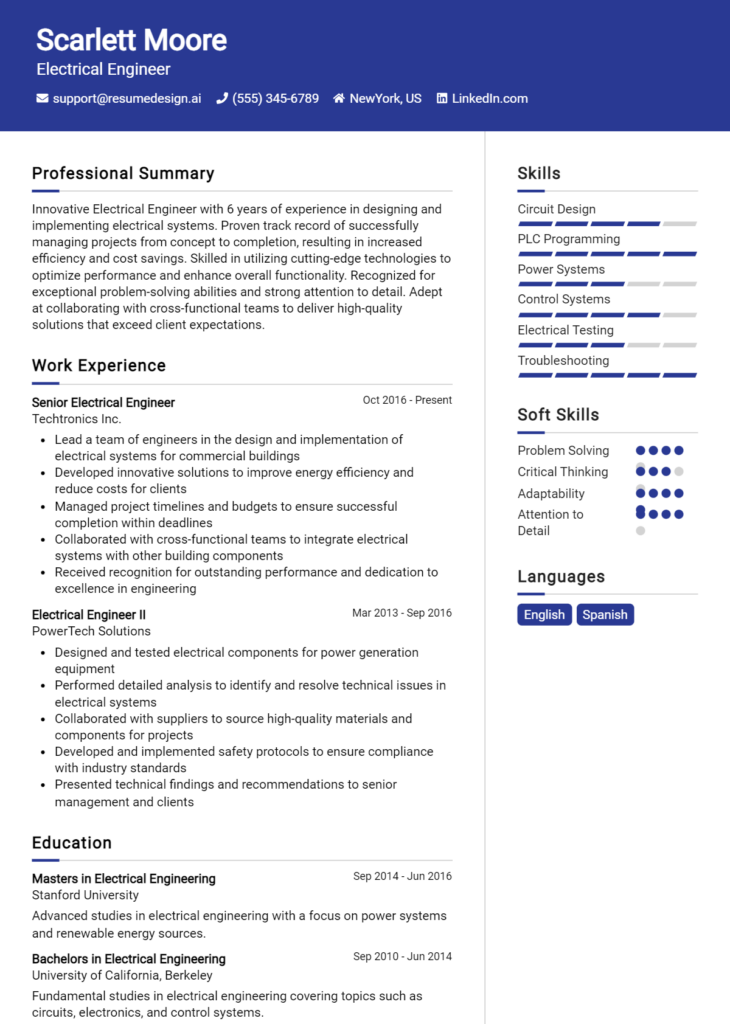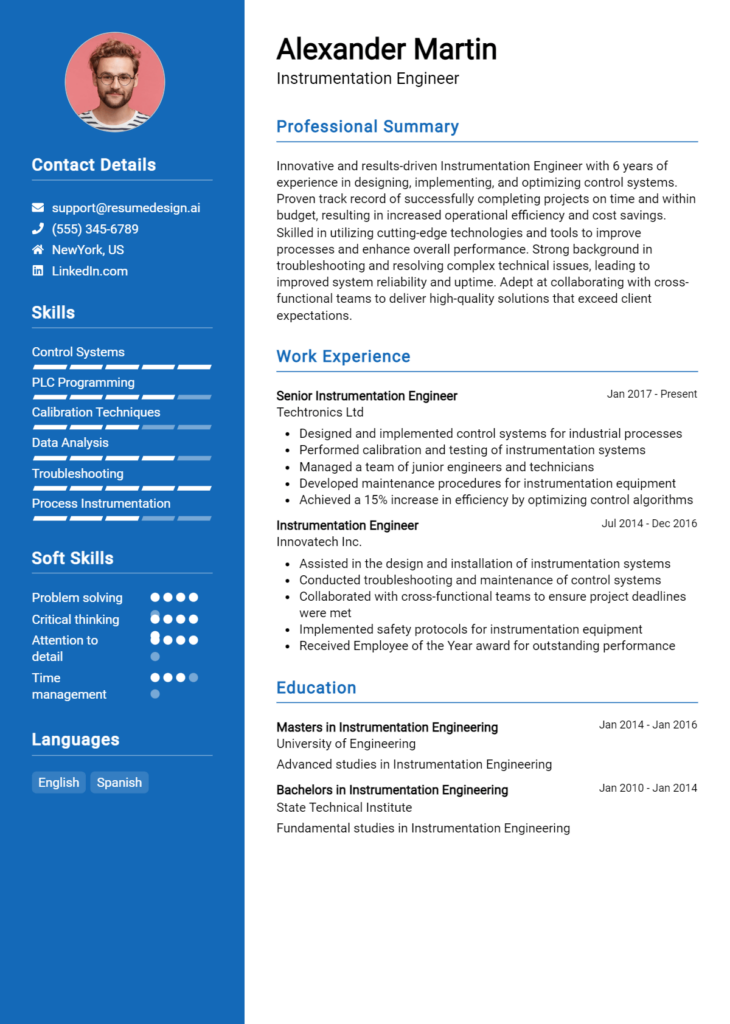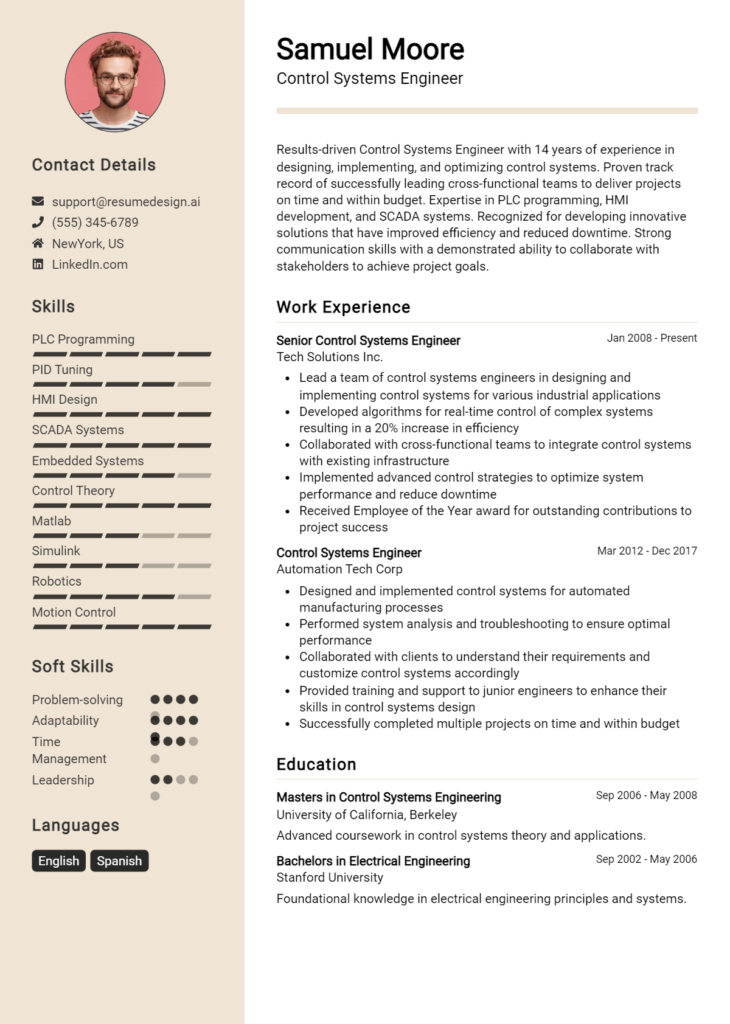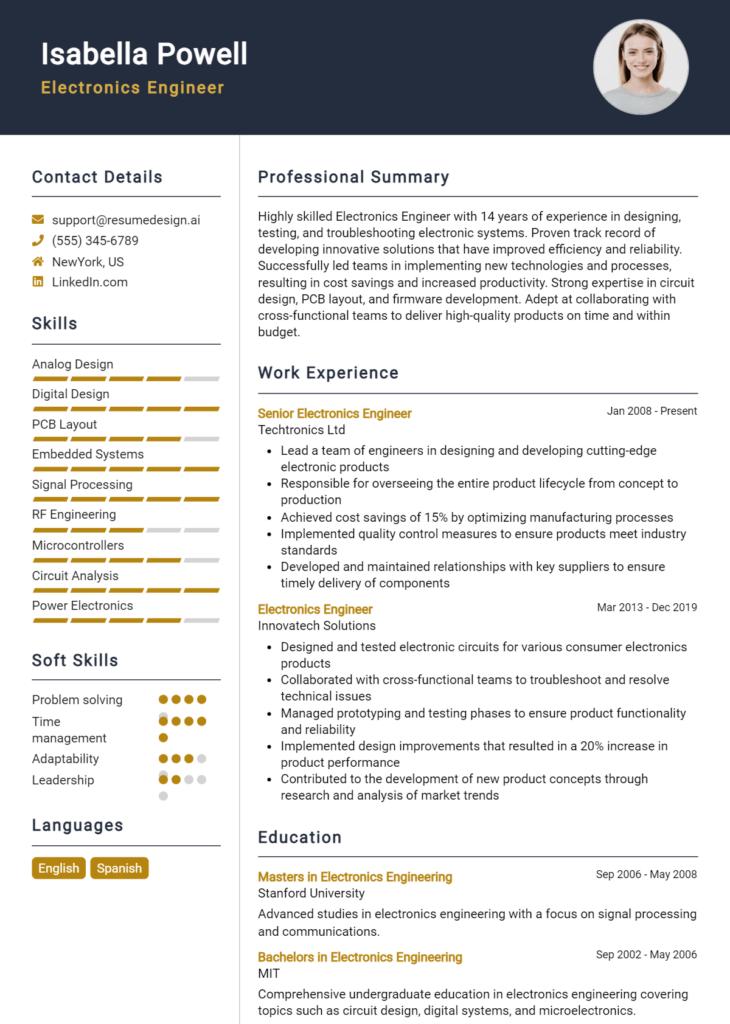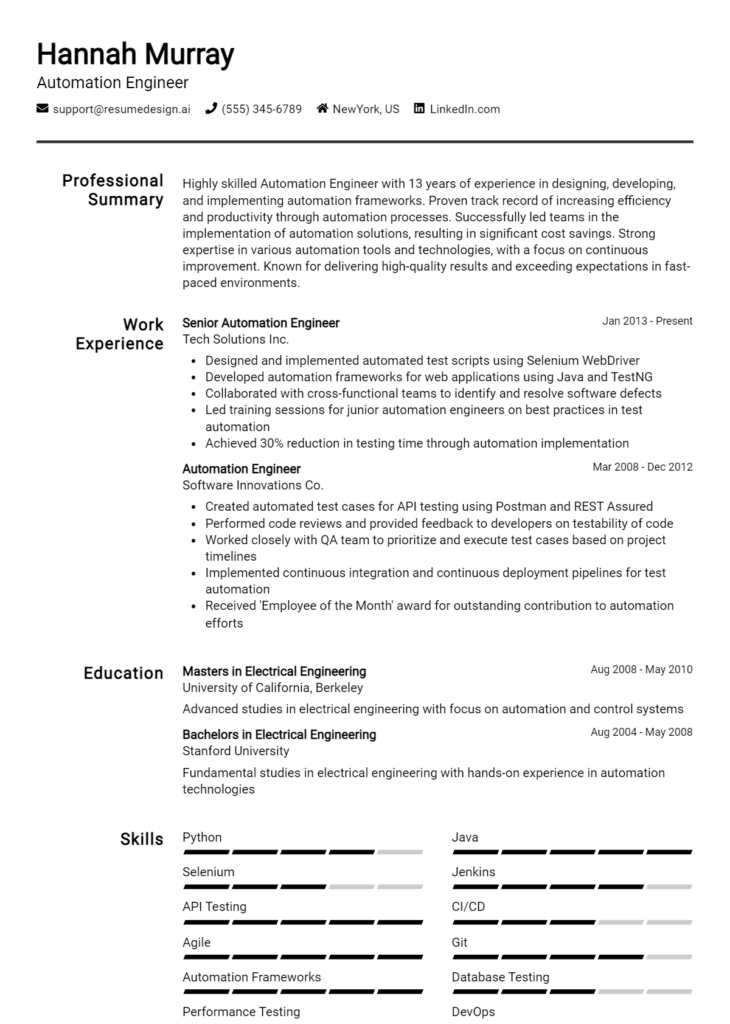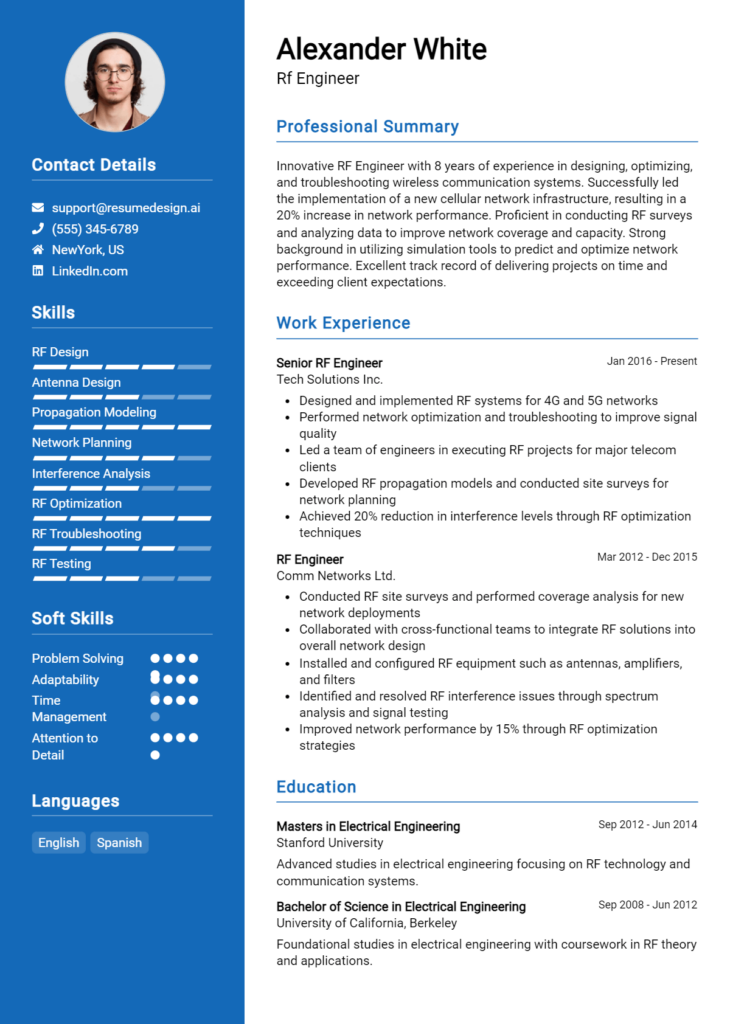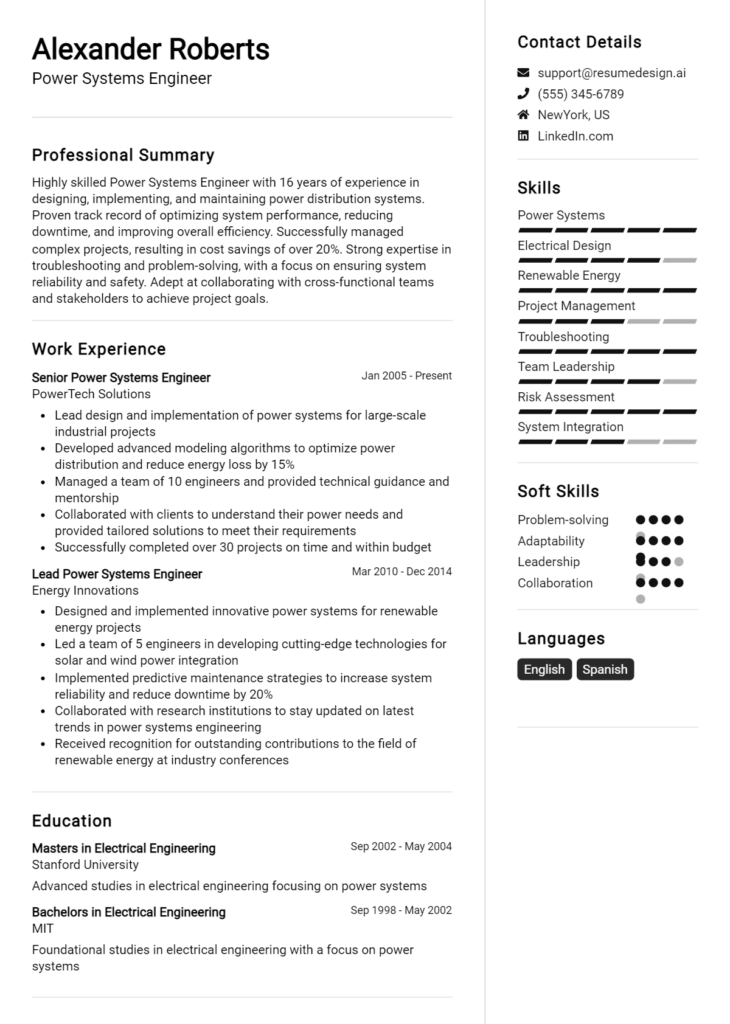Circuit Design Engineer Core Responsibilities
A Circuit Design Engineer plays a pivotal role in creating and optimizing electronic circuits, requiring strong technical skills in electronics and software tools. Their responsibilities include designing, testing, and troubleshooting circuit layouts while collaborating with cross-functional teams such as manufacturing and quality assurance. Problem-solving abilities are essential to address design challenges and ensure functionality, contributing to the organization's overall goals. A well-structured resume highlighting these skills can effectively showcase a candidate's aptitude for this vital role.
Common Responsibilities Listed on Circuit Design Engineer Resume
- Design and develop electronic circuits and systems.
- Conduct simulations and modeling to validate circuit performance.
- Collaborate with multidisciplinary teams for product development.
- Perform testing and debugging of circuit designs.
- Document design specifications and technical reports.
- Implement design improvements based on testing feedback.
- Ensure compliance with industry standards and regulations.
- Utilize CAD tools for circuit layout and schematic design.
- Provide technical support during the production phase.
- Analyze and resolve circuit-related issues in a timely manner.
- Stay updated with emerging technologies and design trends.
- Participate in design reviews and peer evaluations.
High-Level Resume Tips for Circuit Design Engineer Professionals
In the competitive field of circuit design engineering, a well-crafted resume is not just a formality; it is often the first impression a candidate makes on a potential employer. A strong resume serves as a marketing tool that showcases your unique skills, experiences, and achievements in a way that aligns with the requirements of the job you're applying for. It's essential for Circuit Design Engineer professionals to present their technical expertise and project contributions effectively, as hiring managers sift through numerous applications to find the best fit for their team. This guide will provide practical and actionable resume tips specifically tailored for Circuit Design Engineer professionals, ensuring your resume stands out and accurately reflects your capabilities.
Top Resume Tips for Circuit Design Engineer Professionals
- Tailor your resume to the specific job description by including keywords and phrases that match the requirements.
- Start with a strong summary statement that highlights your years of experience, areas of expertise, and key achievements in circuit design.
- Showcase relevant experience by detailing projects you've worked on, including the technologies used and your specific contributions.
- Quantify your achievements where possible, such as improvements in efficiency, cost savings, or successful project completions.
- Highlight industry-specific skills, such as proficiency in PCB design software, simulation tools, and circuit analysis techniques.
- Include relevant certifications and educational background that demonstrate your qualifications and commitment to continuous learning.
- Utilize bullet points for clarity and brevity, making your accomplishments easy to read and understand at a glance.
- Incorporate soft skills like teamwork, communication, and problem-solving, which are essential in collaborative engineering environments.
- Keep formatting professional and consistent, using clear headings, uniform font sizes, and ample white space for readability.
- Proofread your resume thoroughly to eliminate any spelling or grammatical errors, as attention to detail is critical in engineering roles.
By implementing these tips, you can significantly increase your chances of landing a job in the Circuit Design Engineer field. A polished and strategically crafted resume not only highlights your qualifications but also demonstrates your professionalism and attention to detail—qualities that are highly valued in the engineering industry.
Why Resume Headlines & Titles are Important for Circuit Design Engineer
In the competitive field of circuit design engineering, a well-crafted resume headline or title serves as a vital first impression that can significantly influence a hiring manager's perception of a candidate. A strong headline succinctly encapsulates the candidate’s key qualifications and strengths, allowing them to stand out amidst a sea of applications. It should be concise, relevant, and directly aligned with the specific job being pursued, ensuring that it captures the essence of the candidate's expertise and value proposition in just a few impactful words. By doing so, it not only grabs attention but also sets the tone for the rest of the resume.
Best Practices for Crafting Resume Headlines for Circuit Design Engineer
- Keep it concise: Aim for a headline that is brief but informative, ideally no more than 10-15 words.
- Be role-specific: Tailor the headline to reflect the specific position and industry, using relevant keywords.
- Highlight key skills: Incorporate core competencies or technical skills that align with the job requirements.
- Showcase accomplishments: If applicable, mention notable achievements that demonstrate your impact in previous roles.
- Use action-oriented language: Begin with strong action verbs to convey confidence and proactivity.
- Maintain professionalism: Ensure that the tone reflects the seriousness and technical nature of the engineering field.
- Avoid clichés: Steer clear of overused phrases that may dilute the uniqueness of your profile.
- Stay relevant: Regularly update your headline to reflect your most current skills and experiences.
Example Resume Headlines for Circuit Design Engineer
Strong Resume Headlines
Innovative Circuit Design Engineer with 5+ Years of Experience in High-Speed Digital Systems
Results-Driven Electrical Engineer Specializing in PCB Design and Signal Integrity Analysis
Expert Circuit Designer with Proven Track Record in Reducing Production Costs by 30%
Creative Problem Solver in Circuit Design with Extensive Experience in CAD Tools
Weak Resume Headlines
Engineer Looking for Opportunities
Circuit Designer with Experience
Electrical Engineering Professional
The strong headlines are effective because they provide immediate insight into the candidate's specific skills, experiences, and achievements, making them relevant and appealing to hiring managers. They convey a sense of expertise and confidence, enticing employers to read further. In contrast, the weak headlines fail to impress as they are vague and lack detail, leaving hiring managers with little understanding of the candidate’s qualifications or what sets them apart from the competition. This lack of specificity can lead to missed opportunities, as generic titles do not capture the attention required to stand out in a crowded job market.
Writing an Exceptional Circuit Design Engineer Resume Summary
A well-crafted resume summary is crucial for a Circuit Design Engineer as it serves as the first impression to hiring managers who sift through numerous applications. A strong summary quickly captures attention by succinctly showcasing key skills, relevant experience, and notable accomplishments that align with the job requirements. In an industry where technical expertise and precision are paramount, a concise and impactful summary tailored to the specific position can effectively highlight the candidate's qualifications, making them stand out in a competitive field.
Best Practices for Writing a Circuit Design Engineer Resume Summary
- Quantify Achievements: Use numbers or percentages to demonstrate the impact of your work, such as reduced design time or improved circuit efficiency.
- Focus on Key Skills: Highlight specific technical skills relevant to circuit design, such as proficiency in CAD software, simulation tools, or knowledge of semiconductor technology.
- Tailor to Job Description: Customize your summary to reflect the requirements and keywords from the job listing to demonstrate a direct fit for the role.
- Be Concise: Keep your summary to 2-4 sentences, ensuring every word adds value and conveys essential information efficiently.
- Highlight Relevant Experience: Mention years of experience and specific industries you’ve worked in to establish credibility and context.
- Showcase Technical Accomplishments: Include specific projects or innovations that showcase your expertise and contributions to previous employers.
- Maintain Professional Tone: Use professional language and avoid jargon that may not be understood outside your immediate field.
- Stay Positive: Use affirmative language that reflects confidence in your abilities and contributions to the field of circuit design.
Example Circuit Design Engineer Resume Summaries
Strong Resume Summaries
Dynamic Circuit Design Engineer with over 7 years of experience in developing high-performance analog circuits, achieving a 30% reduction in power consumption for major projects. Proficient in using Altium Designer and MATLAB for circuit simulations and validations.
Results-driven Circuit Design Engineer with a proven track record of leading cross-functional teams to deliver complex designs on schedule. Successfully designed a low-noise amplifier that improved signal integrity by 25%, enhancing overall system performance.
Detail-oriented Circuit Design Engineer with expertise in RF circuit design and testing, contributing to a 40% increase in product reliability at XYZ Corp. Skilled in SPICE simulation and PCB layout, recognized for innovative solutions to reduce manufacturing costs.
Weak Resume Summaries
Experienced Circuit Design Engineer looking for a new opportunity. I have worked on various projects and have some skills in design and testing.
Circuit Design Engineer with knowledge of circuits and electronics. I am seeking a position where I can apply my skills and grow professionally.
The examples of strong resume summaries are considered effective because they provide specific details, quantify achievements, and directly relate to the job role, showcasing the candidate's relevant skills and experiences. In contrast, the weak summaries lack specificity and measurable outcomes, making them too vague and generic to capture the attention of hiring managers.
Work Experience Section for Circuit Design Engineer Resume
The work experience section of a Circuit Design Engineer resume is vital as it serves as a showcase for the candidate's technical skills and their ability to manage complex projects and teams effectively. This section not only highlights the candidate's hands-on experience with circuit design but also emphasizes their aptitude for delivering high-quality products within project timelines. By quantifying achievements and aligning work experiences with industry standards, candidates can demonstrate their impact in previous roles, making them stand out in a competitive job market.
Best Practices for Circuit Design Engineer Work Experience
- Use specific technical terminology relevant to circuit design to demonstrate expertise.
- Quantify achievements with metrics, such as efficiency improvements or cost reductions.
- Highlight collaboration with cross-functional teams to illustrate teamwork skills.
- Detail your role in project management, including timelines and deliverables.
- Provide context for your achievements by explaining the challenges faced and solutions implemented.
- Align your experience with industry standards and best practices to show relevance.
- Keep descriptions clear and concise, focusing on the most impactful contributions.
- Use action verbs to convey a proactive approach to your responsibilities.
Example Work Experiences for Circuit Design Engineer
Strong Experiences
- Led a team of 5 engineers in the successful design and implementation of a low-power circuit, resulting in a 30% reduction in energy consumption for consumer electronics.
- Developed and validated a high-frequency PCB design that improved signal integrity, achieving a 15% increase in data transfer rates.
- Implemented a new design review process that reduced errors by 25% and accelerated project timelines by 20%.
- Collaborated with software and mechanical teams to integrate circuit designs, enhancing overall product functionality and user experience.
Weak Experiences
- Worked on various circuit design projects.
- Assisted in the development of electronic components.
- Participated in team meetings regarding circuit design.
- Involved in some testing and troubleshooting of circuits.
The examples listed as strong experiences clearly demonstrate quantifiable outcomes, technical leadership, and effective collaboration, showcasing the candidate's contributions and capabilities in a measurable way. In contrast, the weak experiences lack specificity and detail, failing to convey the candidate's impact or the scope of their responsibilities, making it difficult for potential employers to gauge their skills and effectiveness.
Education and Certifications Section for Circuit Design Engineer Resume
The education and certifications section of a Circuit Design Engineer resume plays a crucial role in demonstrating a candidate's academic background and professional qualifications. This section not only showcases the foundational knowledge and skills acquired through formal education but also highlights industry-relevant certifications and ongoing learning efforts. By including pertinent coursework, specialized training, and recognized credentials, candidates can significantly enhance their credibility and showcase their alignment with the demands of the job role, ultimately increasing their chances of standing out to potential employers.
Best Practices for Circuit Design Engineer Education and Certifications
- Focus on relevant degrees in Electrical Engineering or related fields.
- Include industry-recognized certifications such as Certified Electronics Technician (CET) or IPC Certification.
- List any specialized training in circuit design software (e.g., Cadence, Altium).
- Highlight advanced degrees (Master's or PhD) that provide a competitive edge.
- Provide details on relevant coursework that directly applies to circuit design.
- Keep certifications up to date to reflect continuous professional development.
- Organize the section in reverse chronological order to emphasize recent achievements.
- Consider including GPA or honors if they reflect strong academic performance.
Example Education and Certifications for Circuit Design Engineer
Strong Examples
- Bachelor of Science in Electrical Engineering, University of Technology, 2022
- Certified Electronics Technician (CET), National Institute for Certification in Engineering Technologies, 2023
- Coursework: Advanced Circuit Design, Digital Signal Processing, and Microelectronics.
- Altium Designer Training Certificate, Altium Academy, 2023
Weak Examples
- Associate Degree in General Studies, Community College, 2015
- Certification in Basic Computer Skills, Online Learning Platform, 2020
- Coursework: Introduction to Psychology, Art History.
- High School Diploma, Local High School, 2012
The strong examples are considered effective because they directly align with the skills and knowledge required for a Circuit Design Engineer, showcasing relevant degrees, certifications, and coursework that demonstrate the candidate's qualifications in the field. In contrast, the weak examples lack relevance to circuit design and engineering, featuring general or outdated qualifications that do not contribute to the candidate's credibility in the specialized area of circuit design engineering.
Top Skills & Keywords for Circuit Design Engineer Resume
As a Circuit Design Engineer, the importance of showcasing the right skills on your resume cannot be overstated. Employers are looking for candidates who not only possess technical expertise but also demonstrate the ability to navigate challenges in a fast-paced environment. A well-rounded resume that highlights both hard and soft skills can set you apart from the competition. Hard skills reflect your technical abilities and proficiency in tools and methodologies specific to circuit design, while soft skills illustrate your problem-solving, communication, and teamwork capabilities. Crafting a resume that effectively combines these elements is essential for attracting potential employers and showcasing your qualifications for the role.
Top Hard & Soft Skills for Circuit Design Engineer
Soft Skills
- Problem-Solving
- Communication
- Team Collaboration
- Attention to Detail
- Time Management
- Adaptability
- Creativity
- Critical Thinking
- Project Management
- Leadership
Hard Skills
- Circuit Simulation and Modeling
- PCB Design and Layout
- Schematic Capture
- Knowledge of Electronic Components
- Proficiency in EDA Tools (e.g., Altium, Cadence)
- Signal Integrity Analysis
- Power Distribution Network Design
- Embedded Systems Design
- Familiarity with Microcontrollers and FPGAs
- Understanding of Analog and Digital Circuitry
For more insights on the essential skills you should include in your resume and how to effectively present your work experience, consider exploring additional resources to ensure your resume stands out.
Stand Out with a Winning Circuit Design Engineer Cover Letter
I am writing to express my interest in the Circuit Design Engineer position at [Company Name], as advertised on [Job Board/Company Website]. With a Bachelor’s degree in Electrical Engineering and over [X years] of hands-on experience in circuit design and development, I am excited about the opportunity to contribute to your team. My background in designing complex circuitry and my proficiency in using industry-standard software tools make me a strong candidate for this role.
Throughout my career, I have successfully designed and tested various analog and digital circuits, ensuring they meet stringent performance and reliability standards. My experience includes working with [specific tools or technologies relevant to the job, e.g., SPICE, Altium Designer, etc.], and I have a solid understanding of PCB layout and fabrication processes. At my previous position with [Previous Company Name], I led a team project in developing a low-power RF communication module, which resulted in a 30% reduction in energy consumption while enhancing signal clarity. This experience has honed my skills in problem-solving and collaboration within multidisciplinary teams.
I am particularly drawn to [Company Name] due to its commitment to innovation and sustainability in electronic design. I am impressed by your recent projects, such as [mention any specific project or initiative of the company], and I believe my expertise in circuit optimization and my passion for creating efficient electronic solutions align well with your goals. I am eager to bring my innovative approach and dedication to quality to [Company Name] and contribute to the development of cutting-edge technologies.
I would welcome the opportunity to discuss how my background, skills, and enthusiasms can contribute to the success of your engineering team. Thank you for considering my application. I look forward to the possibility of discussing this exciting opportunity with you.
Common Mistakes to Avoid in a Circuit Design Engineer Resume
When crafting a resume for a Circuit Design Engineer position, it is essential to present your skills and experiences effectively to stand out in a competitive job market. However, many candidates make common mistakes that can undermine their chances of landing an interview. By being aware of these pitfalls, you can create a compelling resume that highlights your qualifications and expertise in circuit design. Here are some common mistakes to avoid:
Generic Objective Statement: Using a one-size-fits-all objective that lacks specificity can make your resume blend in with others. Tailor your objective to reflect your interest in the specific position and the value you bring.
Overloading with Technical Jargon: While technical skills are crucial, using too much jargon can alienate non-technical hiring managers. Strike a balance by explaining complex concepts in a way that is accessible to all readers.
Omitting Relevant Projects: Failing to include significant projects that showcase your circuit design skills can be a missed opportunity. Highlight projects that demonstrate your hands-on experience and problem-solving abilities.
Ignoring Formatting Consistency: Inconsistent formatting can make your resume look unprofessional. Ensure that fonts, bullet points, and spacing are uniform throughout the document for a polished appearance.
Lack of Quantifiable Achievements: Simply listing job duties without quantifying your accomplishments can weaken your resume. Use numbers and specific outcomes to illustrate the impact of your work, such as improved performance metrics or successful project completions.
Neglecting Soft Skills: Focusing solely on technical skills while ignoring soft skills can present an incomplete picture of your capabilities. Include skills like teamwork, communication, and problem-solving, as they are essential in collaborative engineering environments.
Not Tailoring for Each Application: Sending out a generic resume for multiple job applications can reduce your chances of success. Customize your resume for each position by aligning your experiences and skills with the specific requirements of the job.
Skipping the Cover Letter: Foregoing a cover letter can diminish the opportunity to further explain your qualifications and enthusiasm for the role. A well-crafted cover letter can complement your resume and provide additional context to your candidacy.
Conclusion
As a Circuit Design Engineer, you play a crucial role in the development and optimization of electronic circuits that power various technologies. Throughout this article, we've discussed essential skills required for the role, including proficiency in CAD tools, an understanding of semiconductor physics, and the ability to analyze circuit performance. We've also highlighted the importance of staying updated with industry trends and emerging technologies to enhance your design capabilities.
In conclusion, your resume serves as a vital tool in showcasing your expertise and distinguishing yourself in a competitive job market. Take the time to review and refine your Circuit Design Engineer resume to ensure it effectively communicates your skills and experiences.
To assist you in this process, we recommend exploring helpful resources such as resume templates, a user-friendly resume builder, and inspiring resume examples tailored for engineering professionals. Additionally, consider using cover letter templates to complement your application.
Now is the perfect time to elevate your resume and put your best foot forward in your career as a Circuit Design Engineer!

